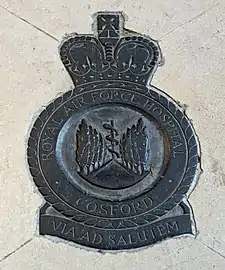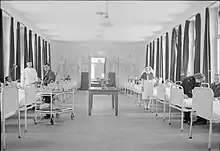RAF Hospital Cosford
RAF Hospital Cosford was a Royal Air Force staffed military hospital at RAF Cosford, Shropshire, England. The hospital opened in 1940, and was one of a handful of Second World War era RAF hospitals that were kept open post Second World War, remaining a military asset until 1977, although it also treated non-service patients. It was known for its personnel reception centre (No. 106 PRC), which dealt with returning prisoners of war in 1945.
| RAF Cosford Hospital | |
|---|---|
 Cosford Hospital badge set into the floor of the church at St Clement's Dane | |
| Geography | |
| Location | RAF Cosford, Shropshire, England |
| Coordinates | 52.651°N 2.289°W |
| Organisation | |
| Care system | Military |
| Funding | Government/NHS |
| Services | |
| Beds | 612 (1941)[1] |
| History | |
| Opened | 1940 |
| Closed | 31 December 1977 |
| Demolished | 1980 |
| Links | |
| Lists | Hospitals in England |
History
The hospital was built on the north eastern part of RAF Cosford, separated from the main technical site by the A41.[2] Originally, the station sick quarters, consisted of several wards, were built as a series of huts on the north western corner of Fulton Block on the main site.[3] However, the regional hospital was developed from 1939 onwards on the eastern site of RAF Cosford. When this newer hospital was opened in 1940, with a complement of eight medical officers,[4][5] the hutted hospital buildings next to Fulton Block were combined into an infectious diseases hospital.[6] In 1941, a burns unit was added to the main hospital, which by the end of the war, had treated 42,000 patients.[7] The specialised unit had 13 beds, equipped to deal with burns victims, and two dedicated saline baths for treatment.[8]
During the Second World War, Cosford became one of the specialist dental units, supplying treatment and training for dental officers. Between 1943 and 1945, a total of 1,128 dental patients were treated ranging from impacted wisdom teeth and cysts, to fractured jaws.[9] Apart from in the depths of winter, extra facilities were pressed into action on the concreted areas outside of the main hospital, with temporary lighting and heating provided. These areas were used for those who were "offensive-smelling long term cases".[10]
The requirement for the number of beds reflected the hospitals role in either wartime or its service support. It should also be noted that Cosford Hospital was open to non-service personnel in the local community after 1948, and the dependents of serving personnel.[11]
No. 106 Personnel Reception Centre
No. 106 Personnel Reception Centre (No. 106 PRC) operated from the hospital between 7 March and August 1945.[12] It was a component of No. 24 Technical (training) Command, and would utilise the nearby airfields of RAF Seighford and RAF Wheaton Aston to ferry former PoWs into the PRC.[13] The PRC was set up to process returning Air Force Prisoners of War (PoW) from the European and Far East Theatres. The necessity for the PRC was reflected in the numbers of PoWs returning from Europe in April and May 1945, which numbered into the tens of thousands.[14] Among the many famous faces that went through No. 106 PRC, was Douglas Bader, who flew into Cosford on his own, and apologised for arriving in the middle of the night.[15]
It was realised that most of the returning PoWs would be drawn from the officer cadre, and space at Cosford was made available by transferring technical training for airmen back to RAF Halton in Buckinghamshire.[16] Due to the volume of returning PoWs, extra flights were laid on to other RAF stations; Dunsfold, Ford, Hixon, Oakley, Odiham, Seighford, Westcott and Wing, and all Royal Air Force personnel would be taken to Cosford.[17] Some were posted straight into the hospital, whereas others could be posted onto No. 4 Medical Rehabilitation Centre, which was also located at Cosford, and saw some patients being assessed in a commandeered section of Fulton Block.[18] An estimation of numbers determined that space at Cosford would allow 3,600 patients at Cosford, with an overspill at RAF Hednesford. It was planned that up to 600 cases a day could be dealt with, but on at least three occasions, over 900 PoWs were assessed within one day.[16] All told, 11,003 returning British PoWs were assessed at Cosford between March and August 1945.[19]
Post war history
On the formation of the NHS in 1948, civilian patients were allowed to use most of the RAF Hospitals up and down the United Kingdom. Among the RAF Hospitals, only St Athan had a midwifery department in 1948, but by 1950, Cosford had opened its midwifery and maternity unit.[11] In the 1960s, the hospital at Cosford was used to conduct research into hypertension.[20]
The hospital was announced for closure in early 1977, and was closed on 31 December 1977.[21][22] In its fnal years, funding for the hospital was allocated solely from NHS accounts, and as such, it was treated as an NHS hospital.[23] The last matron recalled seven RAF staff stood "..in the drizzling rain as the flag[sic] was hauled down for the last time."[24] The main hospital buildings were demolished in 1980.[7]
Badge
The Badge was authorised by the Queen in 1963, and carried the motto of Via ad salutem (Latin: The road to health).[25][26]
Notable people
- John Ainsworth-Davis[27]
- Iris Bower, nurse at the hospital[28]
- John Cooke, medical officer who commanded the medical division at the hospital in the 1950s[29][30]
- Rosaline Few, athlete, was treated at the hospital in February 1977 for suspected appendicitis after taking part in the high jump at an athletics event at RAF Cosford[31]
- Suzi Perry, born at the hospital in the 1970s[32]
References
- Rexford-Welch 1954, p. 194.
- Francis 2012, p. 3.
- Rexford-Welch 1954, p. 192.
- "Celebrating the proud history of RAF Cosford". The Shropshire Star. 26 April 2013. Retrieved 13 September 2021.
- Rexford-Welch 1954, p. 33.
- Francis 2012, p. 125.
- "Shropshire's History Advanced Search | Shropshire's History Advanced Search". shropshirehistory.org.uk. Retrieved 13 September 2021.
- Rexford-Welch 1954, p. 306.
- Rexford-Welch 1954, p. 181.
- Rexford-Welch 1954, p. 195.
- Mackie 2001, p. 211.
- "106 Personnel Reception Centre, formed at Cosford March 1945 and disbanded August 1945..." discovery.nationalarchives.gov.uk. Retrieved 5 September 2021.
- Clutton-Brock 2003, p. 152.
- Clutton-Brock 2003, p. 150.
- Neal, Toby (2 April 2018). "RAF 100: The returning prisoner who captured Marie's heart". The Shropshire Star. Retrieved 6 September 2021.
- Rexford-Welch 1954, p. 589.
- Clutton-Brock 2003, pp. 151–152.
- Rexford-Welch 1954, p. 197.
- Clutton-Brock 2003, p. 153.
- Hopson, J. A. (5 October 1968). "R.A.F. Medicine--The First 50 Years". BMJ. 4 (5622): 50. doi:10.1136/bmj.4.5622.48. PMC 1912063. PMID 4877880.
- "Cosford Hospital (Hansard, 9 March 1977)". api.parliament.uk. Retrieved 24 December 2021.
- Bowyer, Michael J. F. (2010). Action stations revisited. No. 5, Wales and the Midlands. Cheshire: Crecy Publishing. p. 83. ISBN 978-0-85979-111-3.
- Parliamentary papers. (House of Commons and command). Sessional index for session 1977-78. 47th parliament-4th session 1977-78. 26th and 27th Elizabeth II. 3 November 1977-24 October 1978. London: House of Commons. 1977. p. 15. OCLC 1204794610.
- Mackie 2001, p. 289.
- "Badges of RAF Miscellaneous Units". www.rafweb.org. Retrieved 19 December 2021.
- Pine, L G (1983). A Dictionary of mottoes. London: Routledge & K. Paul. p. 250. ISBN 0-7100-9339-X.
- "Obituary Notices". BMJ. 1 (6004): 288. 31 January 1976. doi:10.1136/bmj.1.6004.287. S2CID 220231664.
- Mackie 2001, p. 179.
- Tait, Mr (5 September 2013). "Air Vice Marshal John Cooke, CB, OBE, FRCP Edin". www.rcpe.ac.uk. Retrieved 13 September 2021.
- Harding, James, ed. (23 June 2011). "Air Vice-Marshal John Cooke - Physician who was Dean of RAF Medicine and then a consultant to the Civil Aviation Authority". The Times. No. 70, 293. p. 57. ISSN 0140-0460.
- Rees-Mogg, William, ed. (28 February 1977). "Athletics". The Times. No. 59945. p. 8. ISSN 0140-0460.
- "Famous folk with county connections". The Shropshire Star. 24 February 2009. Retrieved 12 September 2021.
Sources
- Clutton-Brock, Oliver (2003). Footprints on the Sands of Time : RAF Bomber Command Prisoners-of-War in Germany 1939-1945. London: Grub Street Publishing. ISBN 1904010350.
- Francis, Paul (2012). Airfield Research Group Research Note No. 14: No. 9 Maintenance Unit, RAF Museum Cosford, History and Context. archive.org (Report). Stockport: Airfield Research Group. Retrieved 13 September 2021.
- Mackie, Mary (2001). Sky wards : a history of the Princess Mary's Royal Air Force Nursing Service. London: Robert Hale. ISBN 0-7090-6976-6.
- Rexford-Welch, Samuel Cuthbert (1954). Royal Air Force Medical Services. London: HMSO. OCLC 1072173557.
